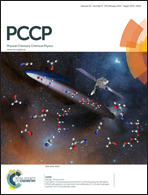Photoelectrochemical scanning droplet cell microscopy for localized photovoltaic investigations on organic semiconductors
Abstract
Photoelectrochemical characterization of the regioregular poly(3-hexylthiophene) (P3HT) was performed using an adapted version of a photoelectrochemical scanning droplet cell microscope (PE-SDCM). The real and imaginary parts of the dielectric function were determined using spectroscopic ellipsometry in order to identify the absorption region of the polymer. Detailed photoelectrochemical experiments were performed for the thin polymer layer contacted with 0.1 M tetrabutylammonium hexafluorophosphate dissolved in propylene carbonate as well as with an electrolyte containing a 5.4 mM ferrocene/ferrocenium redox couple. The effect of the illumination on the P3HT covered WE in contact with both the pure electrolyte and an electrolyte containing a ferrocene/ferrocenium redox couple was studied using dark/illumination sequences. The stability of the photovoltaic effect was characterized using long term current transients. Finally, the photoelectrochemical impedance spectroscopy was applied to determine the electrical properties of the P3HT in the dark and under illumination.


 Please wait while we load your content...
Please wait while we load your content...